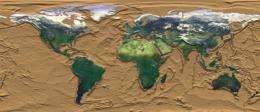New way to track quakes

(Â鶹ÒùÔºOrg.com) -- University of Edinburgh scientists have developed a new technique to monitor movements beneath the Earth's surface.
The new method, which uses data collected from earthquakes, potentially allows the Earth’s seismic activity to be mapped more comprehensively.
Scientists currently monitor underground movements, such as earthquakes and nuclear tests, using seismometers.
The instruments measure the motion of those events at the Earth’s surface, helping to indicate where they took place.
Now the University team has analysed the seismic waves from two different earthquakes.
By doing so, it has been able to simulate the waves from one of the earthquakes as if they were recorded by a seismometer at the location of the second.
The discovery allows earthquakes themselves to be used as virtual seismometers that record passing waves from tremors that happen elsewhere in the world.
Using earthquakes in this way substantially increases the number of locations that could be used to detect seismic activity.
And since earthquakes occur deep inside the Earth, using them also allows scientists to monitor seismic activity from far deeper than previously possible.
"This turns the way we listen to seismic movements on its head. By using earthquakes themselves as virtual microphones, we can listen to the Earth’s stretching and cracking from directly within its most interesting, dynamic places," said Andrew Curtis, professor of mathematical geoscience at the University of Edinburgh.
The research, published in Nature Geoscience, was carried out in collaboration with the British Geological Survey and Utrecht University.
Provided by University of Edinburgh















